|
to Digital |
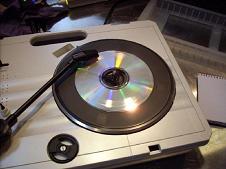
|
Dealing With "Wavering-Pitch", "Pitch-Drifting", or
"Off-Center" Effects When Recording From Vinyl
Converting your vinyl to digital can be done the easy way or the hard way. Sometimes the hard way is better.
The "easy" way is just to plug your turntable into your computer's Line Input jack (and maybe adding a pre-amplifier in-between to bring the phono-cartridge's signal up to line level).
You can't completely eliminate those pops and scratches, but you can make them less objectionable by some moderate equalization. I cut the very-uppermost treble band of my equalizer (15 to 20kHz) down to -12db, with more moderate reductions between 8 - 15kHz of around -5dB if the surface noise is bad enough; but I like my treble, so I try to leave this alone.
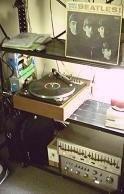
|
•WOW-CORRECTION
But the most bothersome thing about vinyl records is that nearly all of them were pressed off-center. That is, as the record plays on the turntable, you can observe the tonearm slightly sway in-and-out from the center of the disc.
It also means you will hear an audible "wow" effect from the sound as the music is playing. Some folks notice this more than others, but if you listen for some prolonged notes, like a singer holding a high "C", or a piano holding a chord at the end of a solo, you may notice the tone fluctuating in a high-low pattern with each rotation of the record.
There's only one way to fix this and it's not fun.
You need a turntable with a removable spindle.
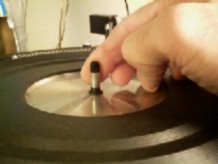
|
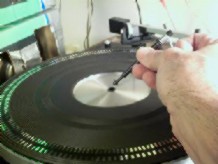
|
First, place the record on the turntable normally, with the spindle in place. Play the record.
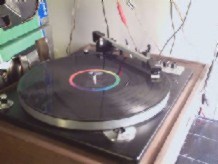
|
Observe the point of the record's rotation where the tonearm is veering to its OUTERMOST POINT (away from the record's center). Be patient; this will require observing the rotation several times.
Then, as you watch the record spin with the tonearm swaying, fix your eyes onto some artifact on the record label (the letter of a word, an illustration, a jot, tittle, etc.) that lines-up with the point of outermost sway. This is so you can identify that section of the record when you stop the turntable.
With the turntable shut off, remove the spindle. Turn the platter so the identifying point on the record label is facing you. You are going to attempt to gently, at a hair's breadth, press the edge of the record so that the grooves move evenly as the record plays.
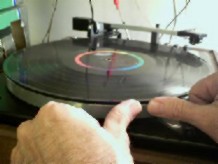
|
(At this point it is probably worth noting that the disc itself is not off-center, but just the groove-pack, so it's not simply a matter of matching the disc's edge to the turntable platter's edge. It's a stamping inaccuracy courtesy of the factory.)
It goes like this: My first "hair's breadth" thumb-roll push slides the record slightly off at another point, which then needs to be corrected in the same manner. (Play the record after each adjustment to check your results). I then repeat the process until there is no more drift by the tonearm when the record plays. If I don't succeed after three attempts, I put the spindle back in and start over.
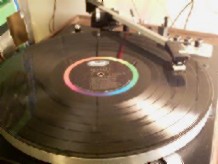
|
I've done this with approximately 100 LP's. As annoying as this procedure may seem, every time I listen to the new "perfected" mp3 recordings of these maddeningly distended records, I get a great sense of satisfaction that I have tamed that "groove-slop" permanently. One strenuous recording session and they're able to be transferred forever to any new technology with just a point and click, while I reflect back at the hours of torture that brought the original file into existence.
•Google: off-center vinyl records, wavering pitch
• Forum thread, "Fixing off-center records -forums.stevehoffman.tv - some good & not-so-good ideas
• Forum thread, "Off-center Pressings" -forums.stevehoffman.tv (2)
| BOTTOM |
| TOP |